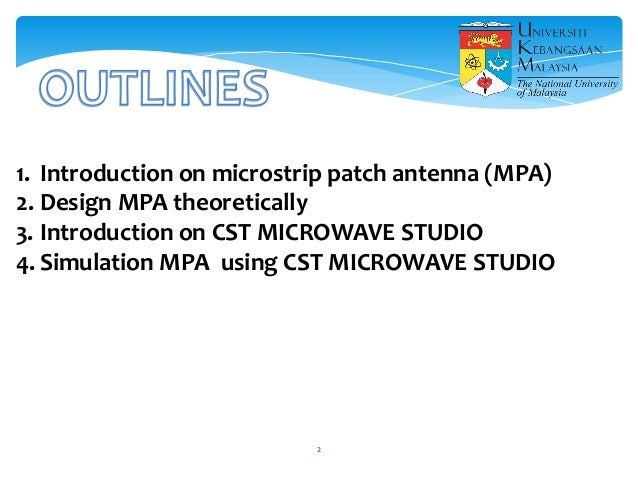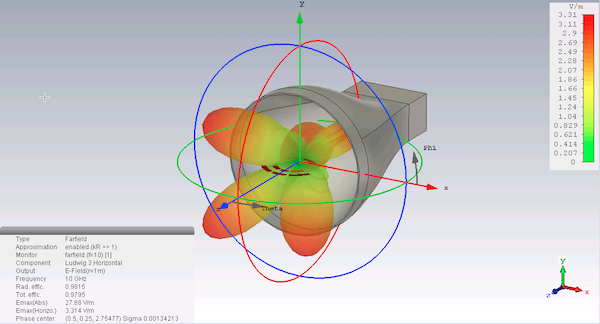

- #CST MICROWAVE STUDIO TUTORIAL ANTENNA DESIGN HOW TO#
- #CST MICROWAVE STUDIO TUTORIAL ANTENNA DESIGN PATCH#
- #CST MICROWAVE STUDIO TUTORIAL ANTENNA DESIGN SOFTWARE#

Observe the directivity and other parameters.Communication system design is getting challenging today since antenna, microwave component and electronics performances have to be proven when they are installed in their working environment. Select far field and see the far field results. Select the return loss plot to observe the curve dips at 1.8 GHz. (note: the simulation might take a long time depending on the speed of the computer) To see the 1D results select 1D results folder S dB. The field monitors can be seen below in the menu. Select H-field/surface current and edit frequency as 1.8 and press apply, then press far field and specify frequency as 1.8 and press apply. Go to solve menu frequency select the range of frequencies. Now check the units from the solve menu. Now design the waveguide port as shown in the fig below.
#CST MICROWAVE STUDIO TUTORIAL ANTENNA DESIGN PATCH#
Select the Microstrip patch face where the the port has to be defined as shown above. The port specifications are shown above.

Now to simulate the Microstrip patch antenna, we must configure ports. And then click on Microstrip and press ENTER. Select patch, go to Boolean from the objects menu and select add. Now the patch and the Microstrip need to be added. The brick coordinates are taken from the calculated fig and shown below. Create a Microstrip line using the calculation as shown in the fig below. The above window appears it is the Boolean window. This calculation is done on paper and is shown in the fig below. Now we come to the most difficult part of designing the transmission lines. Select brick and press escape and give it a name patch and specify the coordinates as shown in the fig. Now to design the patch, come back to the front face and align the local coordinate system to that face. CST Studio Suite Student Edition is ideal for use as part of coursework as well as for anyone wishing to become more proficient with CST Studio Suite.
#CST MICROWAVE STUDIO TUTORIAL ANTENNA DESIGN HOW TO#
Again select the face and select extrude function from the toolbar. Each tutorial includes a descriptive text, a CST Studio Suite file and also a short video showing how to construct each of the models. Select WCS and select align WCS with selected face. To create the ground plane for the antenna, rotate the substrate using the rotate icon given at the top. Select the material as FR-4 from the material library. Specify the height of the substrate h along the positive W axis. So give half of it along negative axis and half of it along positive axis.( Umin = -W & Umax = W) The same way specify Vmin as –L & Vmax as L. To create the substrate, select brick and press escape key. You can design antennas for your specifications as well.) After completing the parameter specifications, turn on the local coordinate system from WCS menu as shown below. (note: since this is for simulation purpose we are giving these values whereas the industrial standards for fabrication will vary) *(Also note that these values are given for the specified frequency to get the results shown here. Fi=12.5, Gpf=1, the thickness of the substrate h=4.5 and the thickness of the copper layer mt=0.1mm. Before starting to design, specify the parameters u got from the theoretical design as shown below. Give size as 100, width as 10 and change the snap width to 0.01 as shown below. Go to edit menu and select the working plane properties. Since Microstrip patch antenna is a planar antenna select Antenna planar in the template. Now launch CST studio and select MicroWave Studio and press OK. The design formula as well as the resonant frequency for which the antenna is designed is given in the fig.
#CST MICROWAVE STUDIO TUTORIAL ANTENNA DESIGN SOFTWARE#
Before going to the software environment, please complete your theoretical design calculations for your specifications as shown in the fig below.

Design of a Microstrip patch antenna using CST MicroWave Studio


 0 kommentar(er)
0 kommentar(er)
